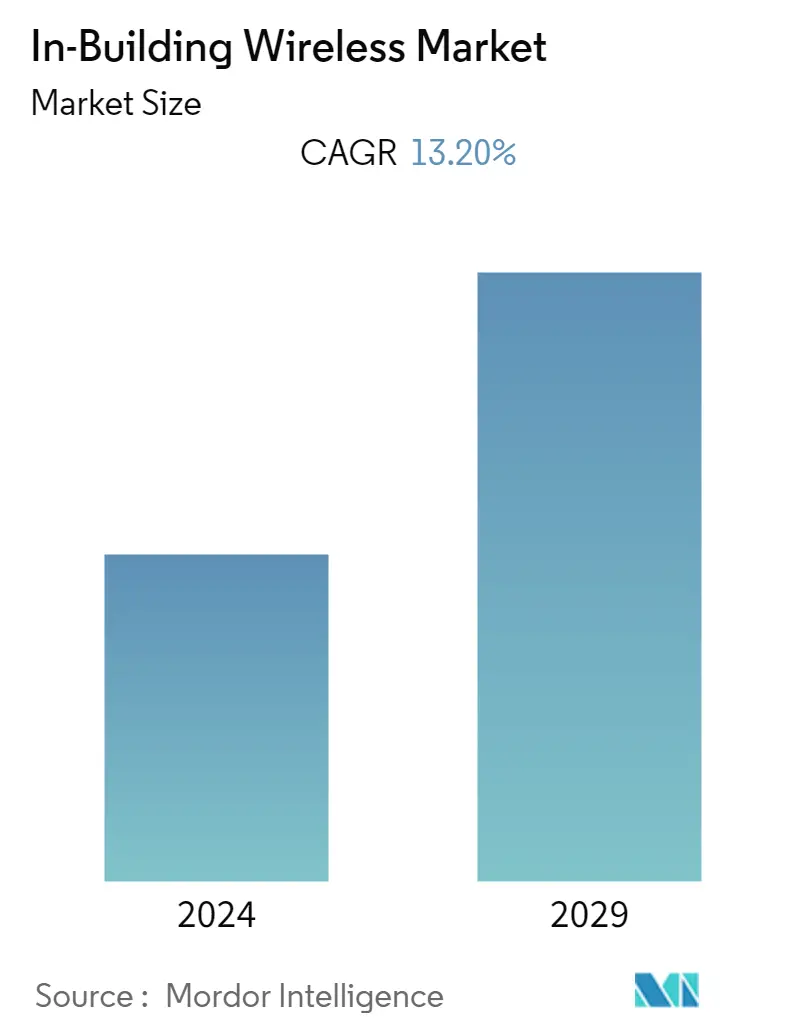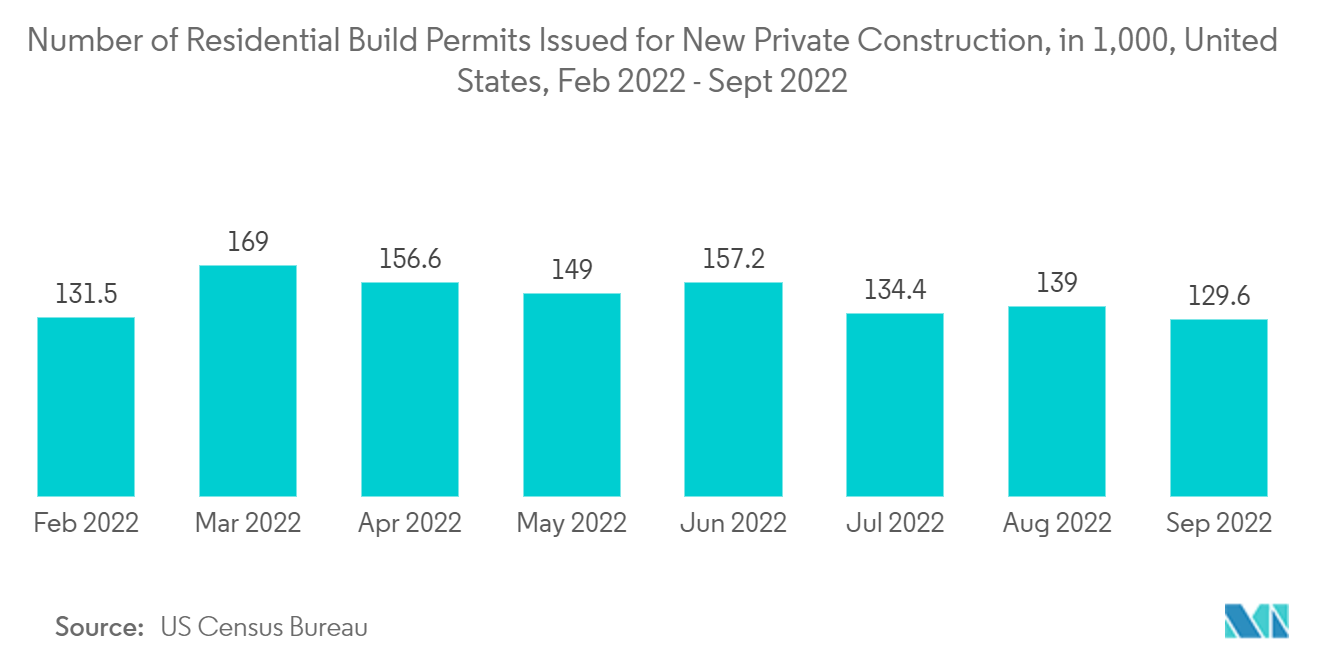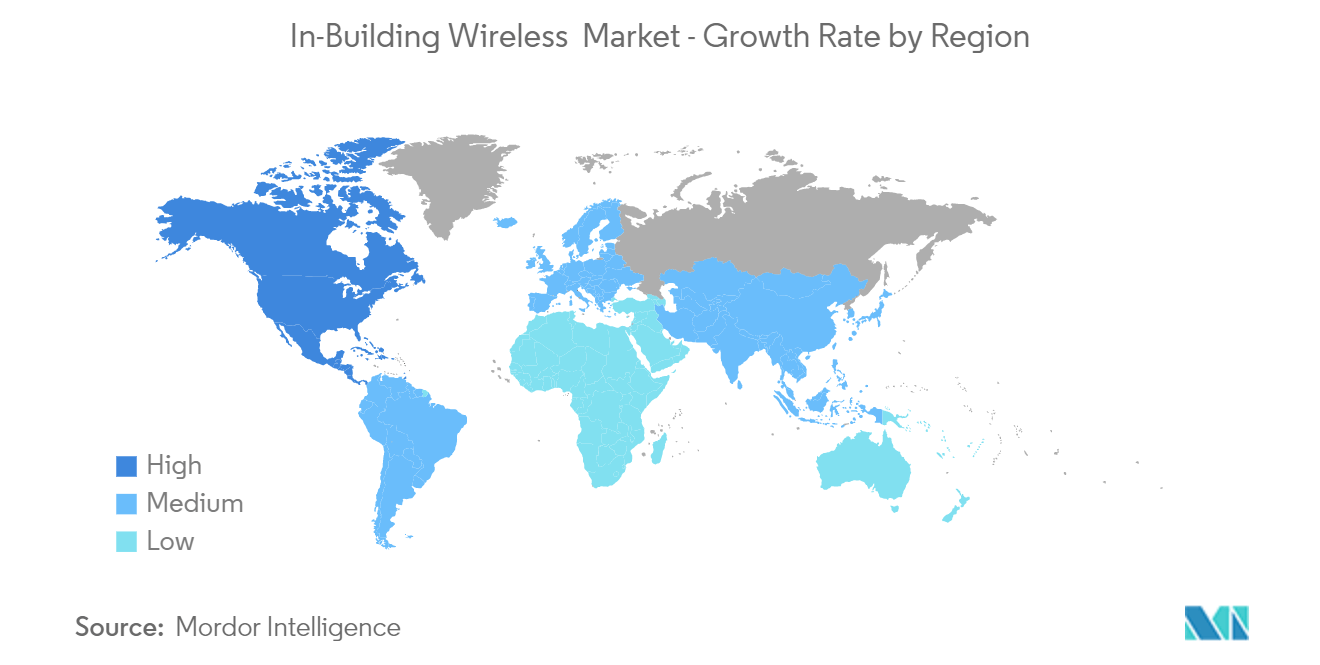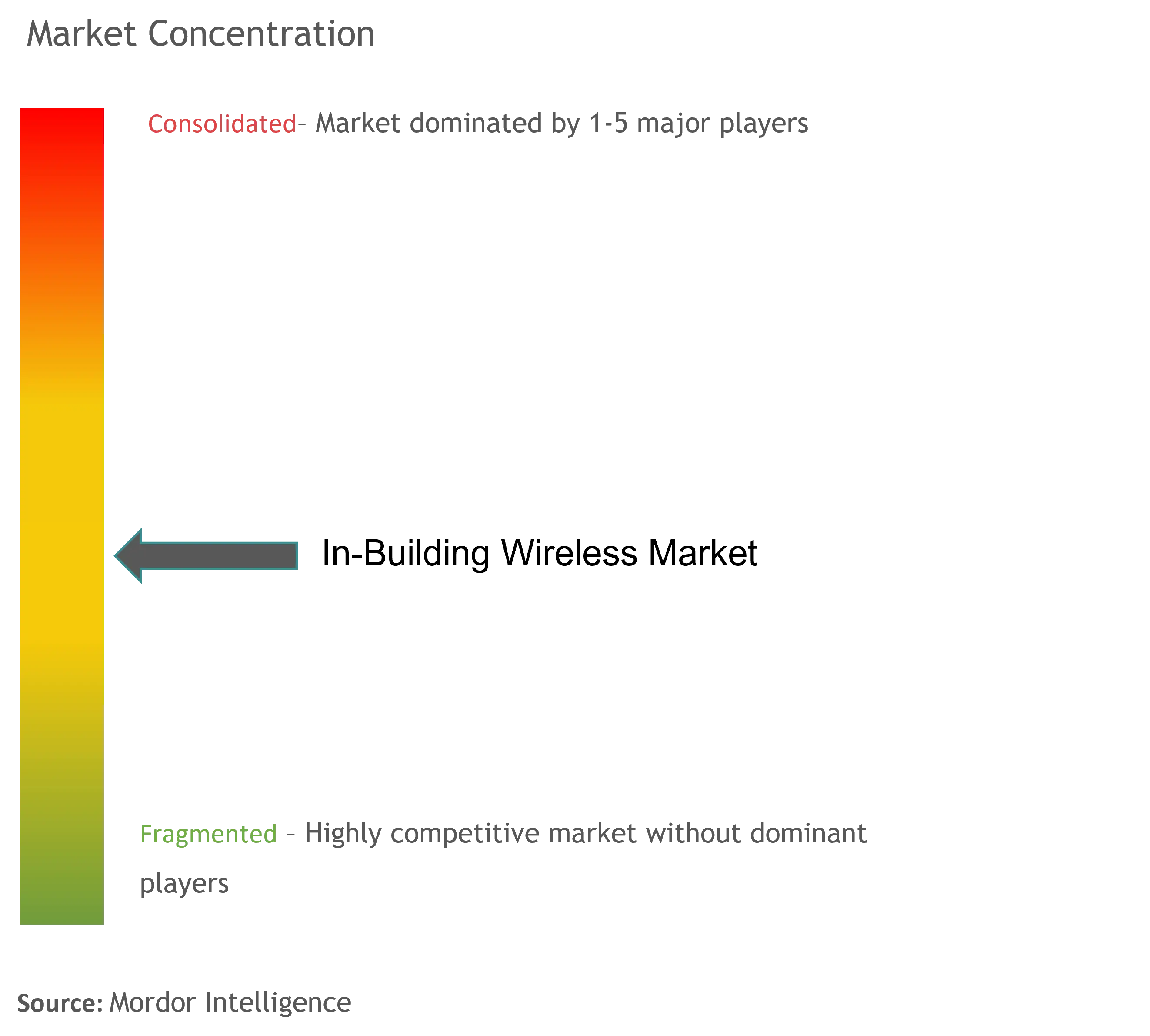In Building Wireless Market Size

| Study Period | 2019 - 2029 |
| Base Year For Estimation | 2023 |
| CAGR | 13.20 % |
| Fastest Growing Market | Asia-Pacific |
| Largest Market | North America |
| Market Concentration | Medium |
Major Players
*Disclaimer: Major Players sorted in no particular order |
In Building Wireless Market Analysis
The in-building wireless market is expected to register a CAGR of 13.2% over the forecasted period. In-building wireless (IBW) solutions off-load the data needs emerging from high-rise buildings, vast campuses, crowded stadiums, and hotel properties to ensure continued connectivity. People expect that 5G will give them a faster and more advanced network connection. This has put a lot of pressure on carriers to give better service to end users.
- Demand is anticipated for the worldwide in-building wireless market during the forecast period. This is mainly because there is a growing need for distinct and defined network coverage, followed by increasing public safety measures being implemented globally. The end-users are now actively hunting for smart technologies and devices to save them time and money due to rapid digital change. In addition, a second element creating new opportunities for market expansion is the developing smart and intelligent construction trend.
- In addition to the trend toward smart and intelligent buildings, the rise in business assurance for mission-critical applications, the need for efficient and robust in-building connectivity, which is influencing the use of in-building wireless solutions in the healthcare sector, and the growing expansion of cellular connectivity across rural areas are all essential factors accelerating the market's growth. Also, more research and development and the availability of unlicensed spectrum in the CBRS and MulteFire bands will give the wireless market new ways to grow during the time frame mentioned above.
- The rise in demand for the studied market is driving firms in the various regions to provide different solutions to capture market share. For example, American Tower provides distributed antenna solutions. Further, the City of Minneapolis manages the Minneapolis Convention Center, which recently marked 30 years in business. The 1.6 million square foot building includes 87 meeting rooms, two ballrooms, a 3,400-seat fixed-seat theater, and 475,000 square feet of display space. The Minneapolis Convention Center can provide an excellent wireless experience for guests, vendors, and workers thanks to an American Tower DAS solution.
- Many business buildings have been evacuated and sealed down due to the pandemic, putting many long-planned inside-building projects on hold. Businesses in most industries have seized the chance to address any issues that could have existed in their facilities before the shutdown and finish urgent renovations and repairs before staff, students, and customers return. During this period, addressing the problems caused by inadequate cellular coverage has received special attention. Because of the epidemic, cell phone coverage inside buildings is even more important to keep personal and professional relationships going and keep the public safe.
- Although network management provides excellent benefits, specific challenges, like reliability concerns, may obstruct the market's growth over the forecast period. Hiring a third-party networking infrastructure vendor to host critical business infrastructure entails trusting that the provider's business will last. In case of any failure by the providers to sustain competition in the market, the enterprises relying upon them may have to entirely replace critical pieces of infrastructure, without which it is not possible to conduct business.
In Building Wireless Market Trends
This section covers the major market trends shaping the In-Building Wireless Market according to our research experts:
Residential is Expected to Hold the Major Share
- According to the US Census Bureau, in early 2020, the number of building permits for new residential construction in the U.S. rose, reaching a peak of 169,000 units in March last year. With more than 11 units approved per 1,000 population, Idaho and Utah have the greatest rate of new residential buildings in the United States.
- Despite COVID-19's effects, residential construction increased throughout Europe. The ZAC Campus Grand Prac Mixed-Use Development (USD 7,000 million projects), Milanosesto Mixed-Use Complex (USD 6,829 million projects), Camden Goods Yard Mixed-Use Community (USD 841 million projects), Viaduct Mixed-Use Community (USD 333 million projects), and Sackville Road Residential Community are some of the most significant multi-family housing construction projects launched in Europe during Q3 of last year. Therefore, it is anticipated that a rise in residential construction will increase demand for the studied market.
- According to the China Construction Industry Association, residential structures made up most of the previous year's finished construction in China. Buildings intended for housing accounted for over 67% of completed floorspace. As the country's economy grows, people migrate from rural areas to major cities, increasing demand for residential accommodation in these locations. Furthermore, apartments utilized as investment properties drive up demand.
- According to the IBEF, India invested USD 2.4 billion in real estate assets over the last year, a 52 percent increase year on year. From April 2000 to September last year, FDI in the industry, comprising construction, development, and operations, totaled USD 55.18 billion. If the price of real estate went up a lot, it would give the market a chance to grow.
- The company provides various solutions for residential use. For example, VeriDAS Technologies specializes in in-building wireless systems for multi-tenant housing and residential communities. VeriDAS is a company that designs, installs, validates, and supports wireless distributed antenna systems (DAS) in residential areas. The company's public safety DAS solutions for residential communities meet the standards of local governments, the NFPA (National Fire Protection Agency), and IFC for indoor emergency responder radio frequency signal strength, coverage, and capacity.

Asia-Pacific to Witness the Significant Growth
- The rise of collaborative networking technology can be linked to the growth of the APAC in-building wireless market.For example, with the deployment of G-SRv6, ZTE Corporation and China Mobile collaborated to accomplish the first trial of the G-SRv6 header compression solution. To complete G-SRv6, the firms combined ZTE's high-end router with a provider edge router (PE) and a service router (SR). This enabled the organization to contribute to networking technology developments. The increased demand for broad, dependable wireless cellular connectivity in commercial and residential building environments drives market revenue.
- The need for greater wireless connectivity, as well as advancements in networking technologies, are driving segment demand. For example, the Electronics and Telecommunications Research Institute recently built the world's first 5G indoor distributed antenna system capable of supporting 20 Gbps and 5G service speeds in interior locations. This introduction is expected to contribute to an improved wireless connection in commercial areas.
- In August 2022, Comba Network, a subsidiary of Comba Telecom based in Hong Kong, said that it had been chosen by China Mobile to contribute to the launch of significant deployments of 5G extended picocells. According to a press statement from Comba, this deployment included 20,000 small-cell base stations. In addition, the company stated that it had secured two bid packages in this deal with China Mobile, which included single-mode extended picocell and dual-mode extended picocell.
- According to the government's newly announced Right of Way Rules, telecom operators won't need permission from authorities to erect cell towers or poles or lay wires over private properties. To facilitate the rollout of telecom networks, particularly 5G services, the government has announced rules for using power poles, footover bridges, etc., for installing small mobile radio antennae or laying overhead telecom cables, along with fees. The Indian Telegraph Right of Way (Amendment) Rules, however, issued last year, state that before erecting a mobile tower or pole over a private building or structure, telecom operators must notify the competent government in writing. With less paperwork and the agreement to install the small equipment in existing infrastructure, the vendors will more easily enhance their services and expand.
- The main driving factor in wireless technology development is the constantly evolving standards created to advance router technology. Over the past ten years, wireless router technology has developed steadily, keeping up with advancements in IEE (Institute of Electrical and Electronics Engineers) standards. The top speeds and transmission capacities of networks are often increased by making changes to these standards.

In Building Wireless Industry Overview
The in-building wireless market is moderately competitive owing to the presence of multiple players. The players in the market are adopting strategies like product innovation, mergers, and acquisitions in order to expand their product portfolios, expand their geographic reach, and primarily to stay competitive in the market.
In October 2022, HFCL, a domestic telecom equipment manufacturer, partnered with Qualcomm Technologies to design and develop 5G outdoor small-cell products. In line with its 5G strategy, HFCL's investment in 5G outdoor small cell products will speed up the deployment of 5G networks, improve the 5G user experience, and make the most of the 5G spectrum.
In October 2022, ExteNet Systems has agreed to develop, build, and operate ExteNet's innovative in-building signal and connectivity solutions across all MGM properties in the United States. It is the country's most significant project and will provide users with next-generation connectivity. ExteNet specializes in convergent communications infrastructure solutions such as LTE/5G wireless and fiber-neutral host communications infrastructure.
In Building Wireless Market Leaders
-
Pierson Wireless Corp
-
AT&T, Inc.
-
CommScope, Inc.
-
Corning Incorporated
*Disclaimer: Major Players sorted in no particular order

In Building Wireless Market News
- October 2022: PROSE Technologies, a provider of wireless antenna, transmission, capacity, and coverage solutions, announced today the release of a new Active DAS system for the 5G network. PROSE Technologies has been working closely with operators to help them scale out their backhaul using E-band microwave solutions due to the large offtake capacity of RANs. After understanding the consumers' primary needs, PROSE Technologies offers a variety of solutions to meet those needs.
- October 2022: The US company Corning announced that it is carefully considering the prospect of producing its wireless equipment, such as small cells and distributed antenna systems, in India using the government's incentive program. The Gurugram wireless research center expands the company's US facility.
In Building Wireless Market Report - Table of Contents
1. INTRODUCTION
- 1.1 Study Assumptions and Market Definition
- 1.2 Scope of the Study
2. RESEARCH METHODOLOGY
3. EXECUTIVE SUMMARY
4. MARKET INSIGHTS
- 4.1 Market Overview (Covers the impact due to COVID-19)
-
4.2 Industry Attractiveness - Porter's Five Forces Analysis
- 4.2.1 Bargaining Power of Suppliers
- 4.2.2 Bargaining Power of Consumers
- 4.2.3 Threat of New Entrants
- 4.2.4 Threat of Substitute Products
- 4.2.5 Intensity of Competitive Rivalry
- 4.3 Industry Value Chain Analysis
5. MARKET DYNAMICS
-
5.1 Market Drivers
- 5.1.1 Growing Volume of Data Consumption
- 5.1.2 Increasing Demand for Smooth and uninterrupted Connectivity
-
5.2 Market Challenges
- 5.2.1 Privacy and Security Issues
6. MARKET SEGMENTATION
-
6.1 By Component Type
- 6.1.1 Antenna
- 6.1.2 Distributed Antenna Systems (DAS)
- 6.1.3 Cables
- 6.1.4 Repeaters
- 6.1.5 Small Cells
-
6.2 By End-user Industry
- 6.2.1 Commercial
- 6.2.2 Residential
- 6.2.3 Industrial
-
6.3 Geography
- 6.3.1 North America
- 6.3.2 Europe
- 6.3.3 Asia-Pacific
- 6.3.4 Latin America
- 6.3.5 Middle East & Africa
7. COMPETITIVE LANDSCAPE
-
7.1 Company Profiles
- 7.1.1 Pierson Wireless Corp.
- 7.1.2 Cobham PLC
- 7.1.3 AT&T, Inc.
- 7.1.4 CommScope, Inc.
- 7.1.5 Anixter Inc.
- 7.1.6 Verizon Communications, Inc.
- 7.1.7 Corning Incorporated.
- 7.1.8 Ericsson Inc.
- 7.1.9 TE Connectivity Ltd.
- 7.1.10 Beatcom Incorporated
- 7.1.11 Dali Wireless, Inc.
- *List Not Exhaustive
8. INVESTMENT ANALYSIS
9. FUTURE OF THE MARKET
** Subject To AvailablityIn Building Wireless Industry Segmentation
In-building wireless is a complete cellular solution that gives mobile coverage to every corner of a user's building without having to upgrade the user's existing service or phones.
The in-building wireless market is segmented by component type (antennas, distributed antenna systems, repeaters, small cells, and cables), end-user industry (commercial, residential, and industrial), and geography (North America, Europe, Asia Pacific, Latin America, the Middle East, and Africa).
The market sizes and forecasts are provided in terms of value (USD million) for all the above segments.
| By Component Type | Antenna |
| Distributed Antenna Systems (DAS) | |
| Cables | |
| Repeaters | |
| Small Cells | |
| By End-user Industry | Commercial |
| Residential | |
| Industrial | |
| Geography | North America |
| Europe | |
| Asia-Pacific | |
| Latin America | |
| Middle East & Africa |
In Building Wireless Market Research FAQs
What is the current In-Building Wireless Market size?
The In-Building Wireless Market is projected to register a CAGR of 13.20% during the forecast period (2024-2029)
Who are the key players in In-Building Wireless Market?
Pierson Wireless Corp, AT&T, Inc., CommScope, Inc. and Corning Incorporated are the major companies operating in the In-Building Wireless Market.
Which is the fastest growing region in In-Building Wireless Market?
Asia-Pacific is estimated to grow at the highest CAGR over the forecast period (2024-2029).
Which region has the biggest share in In-Building Wireless Market?
In 2024, the North America accounts for the largest market share in In-Building Wireless Market.
What years does this In-Building Wireless Market cover?
The report covers the In-Building Wireless Market historical market size for years: 2019, 2020, 2021, 2022 and 2023. The report also forecasts the In-Building Wireless Market size for years: 2024, 2025, 2026, 2027, 2028 and 2029.
In Building Wireless Industry Report
Statistics for the 2024 In Building Wireless market share, size and revenue growth rate, created by Mordor Intelligence™ Industry Reports. In Building Wireless analysis includes a market forecast outlook to 2029 and historical overview. Get a sample of this industry analysis as a free report PDF download.



